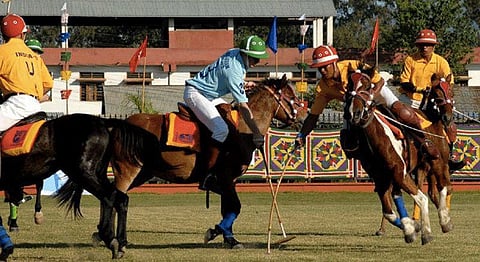
- HOMEGROWN WORLD
- #HGCREATORS
- #HGEXPLORE
- #HGVOICES
- #HGSHOP
- CAREERS
- ABOUT US
- CONTACT US

Along with hunting and horse-riding, Polo has over the course of history emerged as one of the symbols of the elite across the world, polo matches are not simply sporting events but avenues of socialisation of the crème de la crème. But not many know that its origins lie with the Meitei’s of Manipur, to whom the game was quite sacred.
The game is locally known as ‘Sagol Kangjei’, and even has a divine guardian in their traditional culture— god Marjing. Though now a symbol of royalty, it was apparently a celebrated people’s game played by all sections of Manipuri society, so much so that there are local stories of how polo players allegedly pawned their wives to buy a pony. The Meitei had special equestrian ponies reared specifically to play the game, as well as for warfare and ritual purposes. But how did Sagol Kangjei gain international acclaim?
According to conservationist L.Roy, some East India company officials in the mid 19th century watched a Manipuri king play the sport in Assam and joined in. The first club, Silchar Kangjei Club was established in 1833 and the sport grew to popularity in Calcutta as well. Subsequently, it spread to Britain through the colonial officials and was christened ‘polo’ at the Hurlingham Club, where the rules and regulations were written down and consolidated.
Sagol Kangjei is a bit different than the game we know today — players rode barefoot on the ponies without leather saddles and there were no goal posts as well. One scored simply by knocking the ball out of either end of the field. The basics remained the same, just the nuances were made different once the game left the country.
Though once worshipped, the indigenous ponies grew to be in a poor state, reducing drastically in numbers due to lack of grazing grounds as well as falling market value. Manipuri ponies are one of the five indigenous horse breeds of India, and hence also had national importance. Roy and others wanted to preserve them as well as the unique sporting heritage of the state. He organised an international polo tournament in 2016, with the United States Polo Association, where players had to use only Manipuri ponies.
Not only has this aided in conservation efforts, but it has also made Manipur a hotspot for polo with a large number of international visitors. Tourem Pradeepkumar Singh, a member of the Manipuri polo team believes that further steps can be taken such as government aid to maintain ponies as well as establishing grazing grounds in every district. The sport has also seen an increase in the participation of women. Manipur hosts the only international meet for women polo players, and two-thirds of women polo players in India are from Manipur.
Now the claims on the origin of Polo isn’t made by Manipur alone — Iran, Mongolia, and China also allege that they were the fore bringers of the game. That being said, there is no reason for us to not acknowledge the important socio-cultural place the equestrian sport has occupied in the state, and support all efforts going into celebrating, reviving and preserving it.
The 12th Manipur Polo International will be held on the 22nd of November, under the larger umbrella of the Sangai Festival and will go on till November 29th. The participants include the countries of India, Uruguay, Haiti, the United States of America, and England. For more information on the festival, see here.
Representational feature image source: e-pao.net
If you liked this article, we suggest you read:
